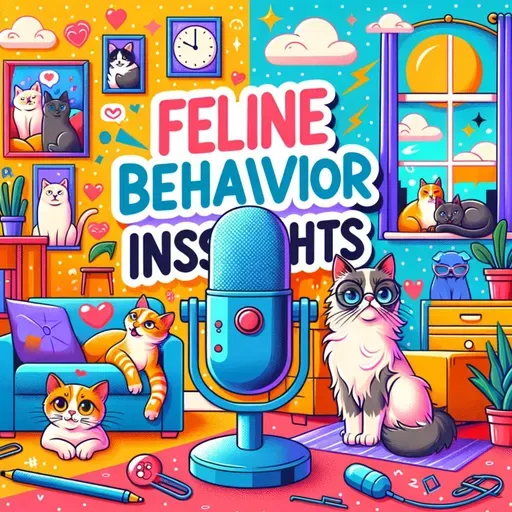
05 September 2025
Decoding Feline Body Language: Unlocking the Window to Your Cat's World
Feline Behavior Insights
About
Feline behavior is a window into a cat’s emotions and their view of the world. According to Tuft & Paw, cats rely heavily on body language to communicate with their humans and other animals. The way a cat positions itself tells you instantly how it’s feeling. When a cat stretches out or lounges openly, that’s a clear signal of relaxation and comfort. On the other hand, if you see a cat balled up with a low, tense posture, or with its tail tucked tightly, that cat is either anxious or feeling threatened. Shape and posture matter because cats, as both predator and prey, are constantly judging whether to protect or open themselves up.
Best Friends Animal Society describes how vocalizations are just a small part of the cat communication repertoire. Instead, attention to their entire body gives the best clues. Relaxed, fluid movements paired with slow blinking or neutral ears indicate a cat at ease. Affectionate cats may circle you, head-butt, or knead, all behaviors rooted in kittenhood and marking favored humans with their scent. Tail language also speaks volumes: a friendly upright tail with a subtle curve is a happy greeting, while a flicking or puffed tail signals agitation or an attempt to look larger in tense situations.
MedVet explains puzzling behaviors like cats pawing or knocking objects over. This isn’t mischief for mischief’s sake; it’s instinctual, tied to their hunting drive and curiosity. Movement triggers their natural fascination, allowing them to practice chasing and pouncing. Bringing toys—or occasionally less delightful gifts—shows that your cat sees you as part of their social group, often trying to share the spoils of their imagined hunt.
The Cats Protection charity in the UK offers practical advice for building trust through body language. Slow blinking, a gentle turn of the head, and respectful distance can reassure your cat as opposed to direct staring, which feels confrontational from a feline point of view. Even behaviors like purring, often interpreted as happiness, have nuance. While a relaxed cat that’s purring is likely content, cats might also purr in stressful or painful situations, so context matters.
Wikipedia points out more peculiar tendencies, such as the righting reflex that helps cats land on their feet when they fall—a marvel of feline agility. Communication and sociability differ widely from cat to cat, shaped by individual experience, environment, and early socialization.
Understanding feline behavior is about more than decoding tail flicks or curious paw swats. It’s an invitation to build trust and foster a healthier relationship with your cat by tuning into the subtle cues they offer every day.
Thank you for tuning in. Remember to subscribe. This has been a quiet please production, for more check out quiet please dot ai.
For more http://www.quietplease.ai
Get the best deals https://amzn.to/3ODvOta
This content was created in partnership and with the help of Artificial Intelligence AI
Best Friends Animal Society describes how vocalizations are just a small part of the cat communication repertoire. Instead, attention to their entire body gives the best clues. Relaxed, fluid movements paired with slow blinking or neutral ears indicate a cat at ease. Affectionate cats may circle you, head-butt, or knead, all behaviors rooted in kittenhood and marking favored humans with their scent. Tail language also speaks volumes: a friendly upright tail with a subtle curve is a happy greeting, while a flicking or puffed tail signals agitation or an attempt to look larger in tense situations.
MedVet explains puzzling behaviors like cats pawing or knocking objects over. This isn’t mischief for mischief’s sake; it’s instinctual, tied to their hunting drive and curiosity. Movement triggers their natural fascination, allowing them to practice chasing and pouncing. Bringing toys—or occasionally less delightful gifts—shows that your cat sees you as part of their social group, often trying to share the spoils of their imagined hunt.
The Cats Protection charity in the UK offers practical advice for building trust through body language. Slow blinking, a gentle turn of the head, and respectful distance can reassure your cat as opposed to direct staring, which feels confrontational from a feline point of view. Even behaviors like purring, often interpreted as happiness, have nuance. While a relaxed cat that’s purring is likely content, cats might also purr in stressful or painful situations, so context matters.
Wikipedia points out more peculiar tendencies, such as the righting reflex that helps cats land on their feet when they fall—a marvel of feline agility. Communication and sociability differ widely from cat to cat, shaped by individual experience, environment, and early socialization.
Understanding feline behavior is about more than decoding tail flicks or curious paw swats. It’s an invitation to build trust and foster a healthier relationship with your cat by tuning into the subtle cues they offer every day.
Thank you for tuning in. Remember to subscribe. This has been a quiet please production, for more check out quiet please dot ai.
For more http://www.quietplease.ai
Get the best deals https://amzn.to/3ODvOta
This content was created in partnership and with the help of Artificial Intelligence AI